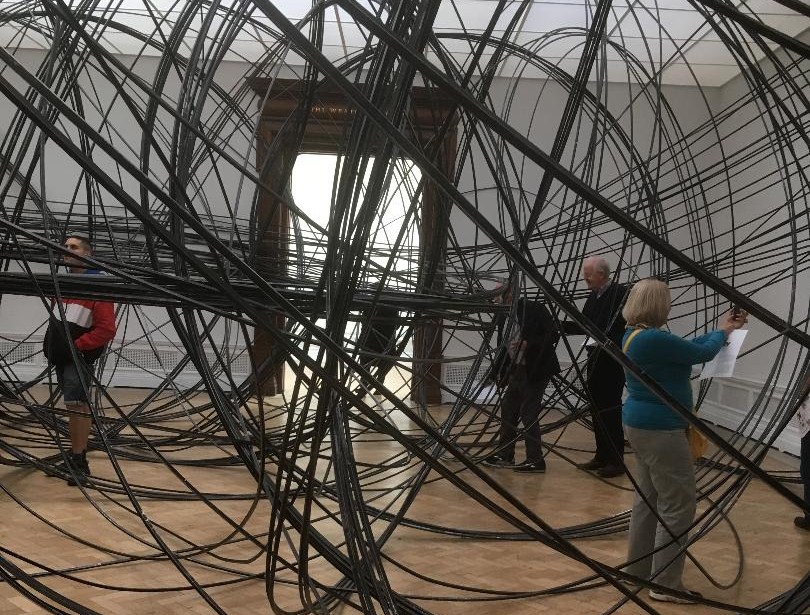17 October 2019
Antony Gormley
At the RA.
Reviewed by Lynda Goetz
 Certain friends highly recommended the Antony Gormley* exhibition, so when last in London I made use of my RA membership to drop in and have a look. I came away musing on ‘The Emperor’s New Clothes’.
Certain friends highly recommended the Antony Gormley* exhibition, so when last in London I made use of my RA membership to drop in and have a look. I came away musing on ‘The Emperor’s New Clothes’.
As I came in from the ‘wrong’ side (ie not the Piccadilly courtyard entrance) I missed the first sculpture in the exhibition, the Iron Baby, and did not see this until I left. It is, as described by the artist, ‘like a small bomb… Here this tiny bit of matter in human form attempts to make us aware of our precarious position in relation to our planetary future. It is the gesture of a body closed in on itself needy of comfort, shelter, sustenance and peace’. Although I failed to see it before the rest of the exhibits I did read the artist’s description in the guide and this set the scene for the rest of the exhibition.
The first room is full of recently created ‘Slabworks’; sculptures created by stacking precision-cut steel slabs in a form recognisably human – rather like Lego characters. One leans against a wall, another huddles in a corner, some lie stretched out. The next room went backwards in time to some early works where the artist’s preoccupation with interiors and exteriors was displayed in various ways. The third room was literally filled with 8 kilometres of square section aluminium tube, coiled and then allowed to expand to occupy the entire space, so that to get through to Gallery 4 you had literally to fight/ wend/ step your way through it. Intriguing. Gallery 4 contained a solitary figure apparently contemplating his feet, or perhaps his shoes or the ground, or all three? He too makes reference to ‘the zone of life beneath the skin’ with tightly packed vertical and horizontal steel bars making up his body.
Making your way back through the twanging coils of aluminium, you reach the beautiful central gallery of the RA. Suspended from the ceiling is Matrix III, a cage, or rather many cages, of recycled steel-reinforcing bars (apparently welded together by hand, although we are not told whose) with a void at the centre called ‘a space of dreaming’, equivalent to the average size of a European new-build bedroom. Quite small. This cage has been described by Gormley as ‘the ghost of the environment we’ve all chosen to accept as our primary habitat’.
It was at this point that I began to lose patience somewhat. That feeling increased as I continued through the further galleries of the exhibition. Gormley’s numerous drawing pads and scribblings exhibited in Gallery 7 are clearly part of the creative process for the man, but they are not particularly distinguished. They contained such thoughts as, ‘I am an artist, I work in the world, with it. I was born in England. That is only a beginning, the starting point; I am aware of the work of other artists. The sum of our work is the culture of our time. I participate in that and hopefully contribute; Art exists in time, but addresses itself to the timeless’. These were clearly musings of a private nature. Had any literate sixth former penned such thoughts for their GCSE workbook, I wonder how their teacher might have regarded them? Some of the drawings of figures contained within a tightly fitting house-shaped space were clearly relatable to much of his thinking over many years.
By the time I had the opportunity to enter the constricted passageway of ‘The Cave’ in Gallery 11, thoughts that I might prefer to rely on my senses to experience a real cave perhaps with running water, plants and moss on the walls had bubbled to the surface. If dark constricted spaces were not your thing, it was possible to go around the edge, but it was pretty hard to tell what the sculpture represented. Apparently, had we been able to view it from above, it was a vast hollow human form crouched on its side. Just as well we were informed, then. Interiors and exteriors again.
Moving on through the next gallery of drawings, which also included some ‘precarious stacks of hand-rolled clay connecting themes of body, building and ground’, the moisture in the air contrasted with the Australian inspired brush drawings. The source – adjoining Gallery 13 filled with clay and sea water; ‘an invasion of the inside by the outside’ according to the artist. This work will transform over the days and months of the exhibition. Does it represent creation or destruction, perhaps a devastating flood? We leave wondering.
Should art need explaining? Should the artist have to draw attention to and point out the meanings within his art? Does it need to be beautiful? For me, navel-gazing on an industrial scale just doesn’t really work. I can be impressed by the scale of it and I can see the point, I’m just not convinced this art of our time is going to be timeless.
The exhibition continues until 3rd December at the Royal Academy, Piccadilly
* Best known for The Angel of The North


